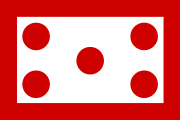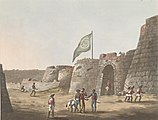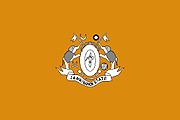Talk:Flag of Karnataka
| This is the talk page for discussing improvements to the Flag of Karnataka article. This is not a forum for general discussion of the article's subject. |
Article policies
|
| Find sources: Google (books · news · scholar · free images · WP refs) · FENS · JSTOR · TWL |
| This article is rated C-class on Wikipedia's content assessment scale. It is of interest to the following WikiProjects: | ||||||||||||||||||||||||
| ||||||||||||||||||||||||
Regarding wrong information
[edit]There is no official flag in Karnataka,this flag is political party flag named kannada paksha. Yellow, white and red flag is one of the flag but it is rejected by the government , so there is no official flag in Karnataka state. Wrong information is given to all of us, And using a political party flag for hosting and other purpose is wrong and against law. Thank you 2402:8100:281B:DBC6:A60:90D0:7EA8:6905 (talk) 23:45, 14 December 2021 (UTC)
A Commons file used on this page or its Wikidata item has been nominated for deletion
[edit]The following Wikimedia Commons file used on this page or its Wikidata item has been nominated for deletion:
Participate in the deletion discussion at the nomination page. —Community Tech bot (talk) 10:38, 23 February 2023 (UTC)
Original research ?
[edit]This flags are not historical flag of Karnataka State.
There is also note on wikicommons to not use this flag on any article without reliable source
This flag is fictitious, proposed, or locally used unofficially. It has not been adopted in an official capacity, and although it may be named as if it was an official flag of a geographical or other entity and have some visual elements that are similar to official logos or flags of that entity, it does not have any official recognition. A flag of this type should not be added to any articles or pages unless it is officially proposed by a government agency, covered by the media, or sees notable local use.
This section looks like original reasearch of editors to push point of view by adding fictional flags with references of kingdoms RI talk 10:04, 4 November 2024 (UTC)
History
[edit]Vijayanagara Empire
[edit]The Vijayanagara Empire was a Hindu empire based in the region of South India, which consisted the modern states of Karnataka, Andhra Pradesh, Tamil Nadu, Kerala, Goa and some parts of Telangana and Maharashtra. Sun, Moon, Dragger and Boar (Varaha) were identified with Royal insignia of the Vijayanagara kings.[1]
Kingdom of Mysore (1880s–1974)
[edit]-
The original flag of the Kingdom of Mysore, and its subsequent Mysore State and the reorganised Karnataka State, began to be used in the 1880s
The present-day Karnataka state went through a series of geopolitical and cultural transformations. After India's independence in 1947, the constitutional changes took nearly three years to come into effect, during which the Kingdom of Mysore remained the state's original form territorially. In 1950, the Kingdom of Mysore was renamed Mysore State when India became a democratic republic, but Maharaja Jayachamarajendra Wadiyar continued to be the chief head of Mysore State (as maharaja, then as rajpramukh, and finally as governor). In 1956, the Reorganisation of States Act on linguistic-basis was passed by the Republic of India, which furthered Mysore State's frontiers. Coastal parts of Mangalore, which previously belonged to Madras Presidency, were incorporated into Mysore State, as well as Kannada-speaking regions of Bombay Presidency (sometimes referred to as Bombay-Karnataka region) and Hyderabad State (Hyderabad-Karnataka region). In 1974, Mysore State was renamed Karnataka State. Until this point, the flag of the Kingdom of Mysore remained the state's flag,[citation needed] official until 1956, and de facto thereafter, until 1974, alongside the bi-coloured Kannada flag. With the renaming of state, pro-Kannada movements throughout Karnataka gained pace, during which the bi-coloured Kannada flag became more prevalent.
The Mysore Kingdom flag was oblong and bi-coloured: a red strip on the top, symbolising vermilion, and a maroon strip on the bottom. In the centre was inscribed the coat of arms of the Kingdom of Mysore. Some synonymous versions of the flag redact the emblem; the original version, however, comes with it inscribed in the centre. The coat of arms bore a mythical two-headed eagle, called Gandabherunda, in Kannada. This emblem itself was an adoption from that of the Vijayanagara Empire. Mysore Kingdom inherited this right after the principality was commissioned in 1399 by Harihara II, anointing Mysore Kingdom's first ruler, Yaduraya Wodeyar, as its ruler.
After the state's renaming in 1974, this flag was gradually decommissioned. Nevertheless, this flag remains, to this day, the official flag of the Mysore royal family, and is used during the private and, sometimes, in public, celebrations of the Dasara festival, including the Special Assembly (khas durbar) during the carnival.[citation needed]
Kingdom of Mysore Under Haider Ali and Tipu Sultan (1761–1799)
[edit]In the second half of the 18th century, the Maharajas of Mysore were reduced to the role of puppet rulers, with the real power held by military rulers, Hyder Ali and Tipu Sultan.
-
Hyder Ali standard
-
Tipu's Naval flag
-
The North Entrance Into The Fort Of Bangalore with Tipu's flag flying
At least 3 flags are known from this period. Hyder Ali standard from Battle of Sholinghur 1781 captured by Madras Regiment. White with a red border, with five red disks was the naval flag used from c. 1784 to 1799, the year of Tipu Sultan's defeat by the British. The weak and primitive local navy disintegrated at the first serious clash with European ships, and with it the flag disappeared.[2] Another flag is a green triangle with gold symbols seen in one of James Hunter's paintings.
Jamkhandi State
[edit]Jamkhandi State was one of the Maratha princely states of British India.[3] It was founded in 1811[4] and its capital was at Jamakhandi.
State flag used until 1948. The state coat of arms without colors appeared on a plain saffron background. An oval shield with a ritual ax flanked by two torches placed on the bordure. Around the shield, supported by two draped elephants with a flag in their trunks, were various figures: above the sun and moon, below various weapons and a scroll with the name of the country.
Mudhol State
[edit]Mudhol State was a princely state during the British Raj. The rulers were from the Ghorpade clan of the Marathas. It was one of the former states of the Southern Maratha Country and its capital was the city of Mudhol.
Ramdurg State
[edit]Ramdurg State was one of the Maratha princely states ruled by the Bhave family during the British Raj. It was administered as part of the Deccan States Agency of the Bombay Presidency, founded in 1799.[5] It was one of the former states of the Southern Maratha Country and its capital was at Ramdurg.
National flag adopted at an unknown date and abolished in 1948. The classic Bhagwa zenza (deep indented square), usually worn with a large orange ribbon. It was also the banner of the ruler.[6]
Sandur State
[edit]Sandur State was a princely state of India during the British Raj, part of the Madras States Agency.[7] Its capital was the town of Sanduru.[8]
State flag adopted at an unknown date and abolished with the state in 1949. Proportions 4/7. The orange field signified the descent of the ruling dynasty from the Maratha Empire. The black and white canton was taken from the insignia of the Armed Forces. Another flag of Sandur, considered a royal flag, featured an emblem consisting of a sun with an umbrella and a lizard on an Bhagwa Dhwaj. The umbrella and the lizard are the crest and badge of the principality's coat of arms respectively.[9] The same emblem appeared on the war flag, it was a white triangle with two black stripes above and below it.[10] There is no evidence to link the design of the national flag with the similar design of the old Georgian flag.
- ^ "Vijayanagara Emblem".
- ^ "Hyderabad e Mysore".
- ^ Imperial Gazetteer of India, v. 14, p. 46.
- ^ Jamkhandi (Princely State)
- ^ Imperial Gazetteer of India, Oxford: Clarendon Press, 1908
- ^ "Maratti2".
- ^ Chisholm, Hugh, ed. (1911). . Encyclopædia Britannica. Vol. 24 (11th ed.). Cambridge University Press. p. 142.
- ^ Imperial Gazetteer of India, v. 22, p. 42.
- ^ "Sandur (Princely State)". 1931.
- ^ "Indiasud2".
- C-Class heraldry and vexillology articles
- WikiProject Heraldry and vexillology articles
- C-Class India articles
- Mid-importance India articles
- C-Class India articles of Mid-importance
- C-Class Karnataka articles
- Unknown-importance Karnataka articles
- C-Class Karnataka articles of Unknown-importance
- WikiProject Karnataka articles
- WikiProject India articles













